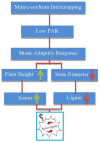Agro-Techniques for Lodging Stress Management in Maize-Soybean Intercropping System-A Review
- PMID: 33212960
- PMCID: PMC7698466
- DOI: 10.3390/plants9111592
Agro-Techniques for Lodging Stress Management in Maize-Soybean Intercropping System-A Review
Abstract
Lodging is one of the most chronic restraints of the maize-soybean intercropping system, which causes a serious threat to agriculture development and sustainability. In the maize-soybean intercropping system, shade is a major causative agent that is triggered by the higher stem length of a maize plant. Many morphological and anatomical characteristics are involved in the lodging phenomenon, along with the chemical configuration of the stem. Due to maize shading, soybean stem evolves the shade avoidance response and resulting in the stem elongation that leads to severe lodging stress. However, the major agro-techniques that are required to explore the lodging stress in the maize-soybean intercropping system for sustainable agriculture have not been precisely elucidated yet. Therefore, the present review is tempted to compare the conceptual insights with preceding published researches and proposed the important techniques which could be applied to overcome the devastating effects of lodging. We further explored that, lodging stress management is dependent on multiple approaches such as agronomical, chemical and genetics which could be helpful to reduce the lodging threats in the maize-soybean intercropping system. Nonetheless, many queries needed to explicate the complex phenomenon of lodging. Henceforth, the agronomists, physiologists, molecular actors and breeders require further exploration to fix this challenging problem.
Keywords: agronomical management; intercropping; lignin metabolism; lodging tolerance; resistance genes.
Conflict of interest statement
The authors declare no conflict of interest.
Figures



References
-
- Oelbermann M., Echarte L. Evaluating soil carbon and nitrogen dynamics in recently established maize-soyabean inter-cropping systems. Eur. J. Soil Sci. 2011;62:35–41. doi: 10.1111/j.1365-2389.2010.01317.x. - DOI
-
- Tscharntke T., Clough Y., Wanger T.C., Jackson L., Motzke I., Perfecto I., Vandermeer J., Whitbread A. Global food security, biodiversity conservation and the future of agricultural intensification. Biol. Conserv. 2012;151:53–59. doi: 10.1016/j.biocon.2012.01.068. - DOI
-
- Rosenberg M. Current World Population. [(accessed on 1 February 2011)];2011 Available online: www.about.com.
-
- Vogel E., Meyer R. Resilience. Elsevier; Amsterdam, The Netherlands: 2018. Climate Change, Climate Extremes, and Global Food Production—Adaptation in the Agricultural Sector; pp. 31–49.
-
- Yang F., Liao D., Fan Y., Gao R., Wu X., Rahman T., Yong T., Liu W., Liu J., Du J., et al. Effect of narrow-row planting patterns on crop competitive and economic advantage in maize–soybean relay strip intercropping system. Plant Prod. Sci. 2016;20:1–11. doi: 10.1080/1343943X.2016.1224553. - DOI
Publication types
Grants and funding
LinkOut - more resources
Full Text Sources

